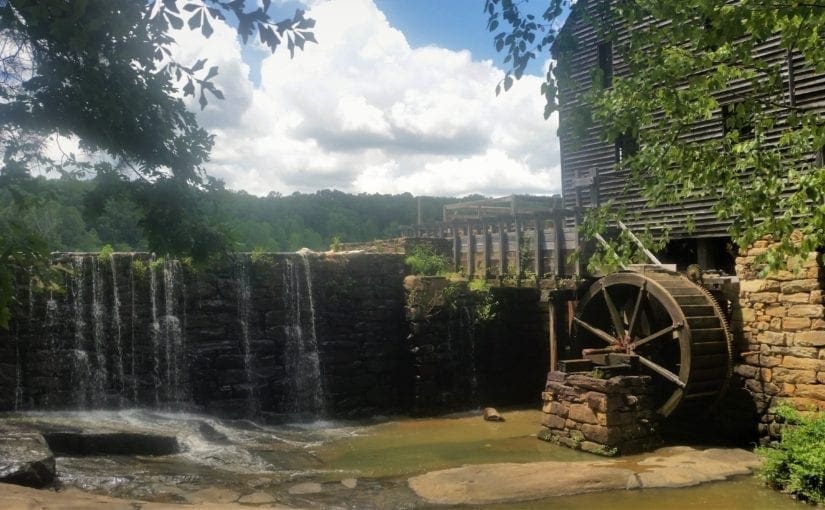Most recently updated January 18th, 2022
Estimated Reading Time: 18 minutes
Historic Yates Mill County Park is not on my usual round of go-to parks.
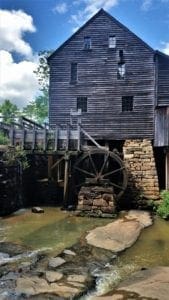
This is mainly because it’s a longer drive for me than either Umstead State Park or Bond Park, both of those parks have longer trails – and these days I’m usually looking more for a place to have a serious hike than to entertain kids.
Raven Rock State Park is another great place to take younger kids, but it’s an hours drive away….
But a couple of weeks ago, I had an hour to spend and didn’t want to get too sweaty.
So I dropped by Historic Yates Mill County Park to take an active break.
I’d visited Yates Mill once before, in the winter, but this visit I got to see what it was like in the summertime.
I wasn’t disappointed.
There’s a pond, a few shorter – mostly shady – flat hiking trails, and fishing (with a permit).
Plus, it’s got a historic working water-driven grist mill. So there’s that 🙂
Based on what I found, if you’ve got grade school or younger kids, or even Middle-schoolers who (unlike mine) DON’T refer to hikes as “forced marches”, Historic Yates Mill County Park could be a wonderful hang-out for your family!
Some of my posts contain affiliate links. If you make a purchase through an affiliate link, I will receive a small payment at no additional cost to you. I do not get paid for recommendations, all opinions on this site are my own. See full Disclosure page here.
About the Park
The 174-acre public park is located in central Wake County, off of Lake Wheeler Road.
Only five miles south of downtown Raleigh, Historic Yates Mill County Park features one of the oldest buildings in Raleigh and the only remaining functioning gristmill in Wake County.
Yates Mill County Park’s main attraction is a restored eighteenth-century water-powered mill.
The old mill on Steep Hill Creek known today as “Yates Mill” has stood on its foundation since the 1750s, despite intervening floods, hurricanes, war and neglect.
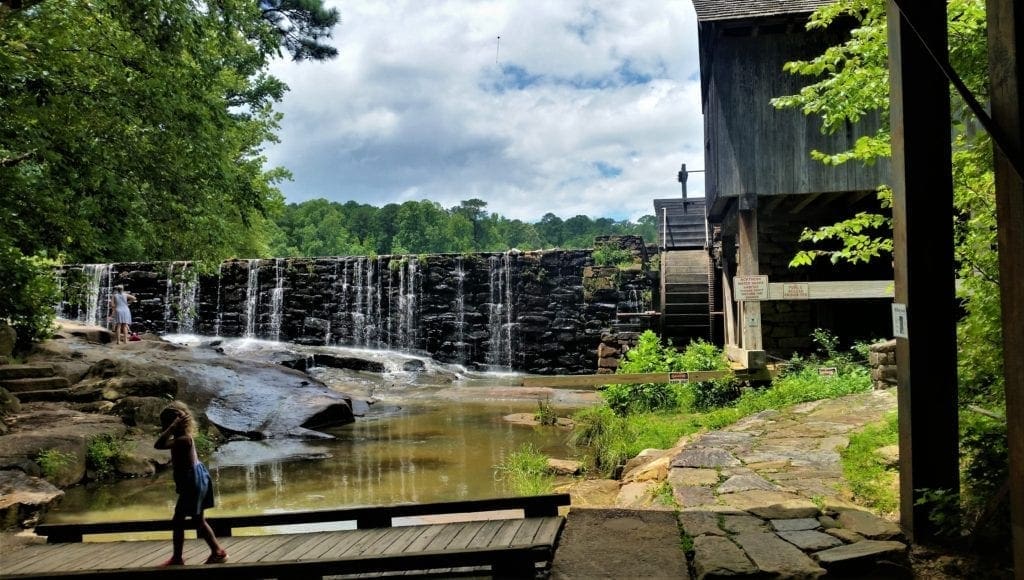
Yates Mill is an example of the Oliver Evans type of grist mill and has been returned to its state as of the mid-19th century.
Today the mill is fully restored and operable – and you can tour it both inside and out!
The park also includes a Visitor Center, a few miles of hiking trails, an environmental research center, and a wildlife refuge, which occupies most of the site.
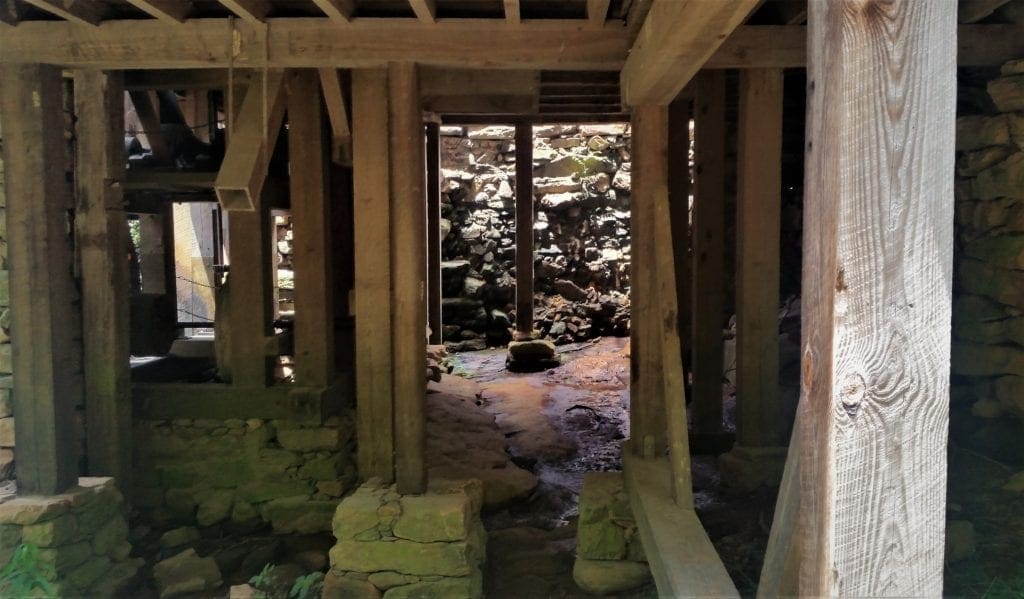
Picnic areas and the visitor center are located to the east of the pond, and a small wooden amphitheater sits on an open lawn near the park entrance.
Park History Highlights
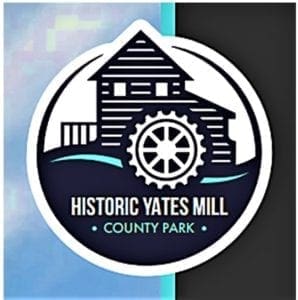
The park was developed by, and is managed through, a partnership effort among Wake County Parks, Recreation and Open Space, NC State University, and the non-profit group Yates Mill Associates (YMA).
Like many land-preservation efforts, the development of Yates Mill County Park took decades to complete:
-
- In 1963 the mill and several hundred surrounding acres were purchased by North Carolina State University (NCSU), which maintains ownership to this day.
- Yates Mill was placed on the National Register of Historic Places in 1974.
- In 1989 the non-profit Yates Mill Associates (YMA) was founded to restore the mill and preserve the landscape’s agricultural heritage.
- In 1996, after stabilizing the mill building, YMA approached Wake County with a proposal to turn Yates Mill into a county park. Park planning between NC State, YMA, Wake County and the North Carolina Department of Agriculture and Consumer Services began.
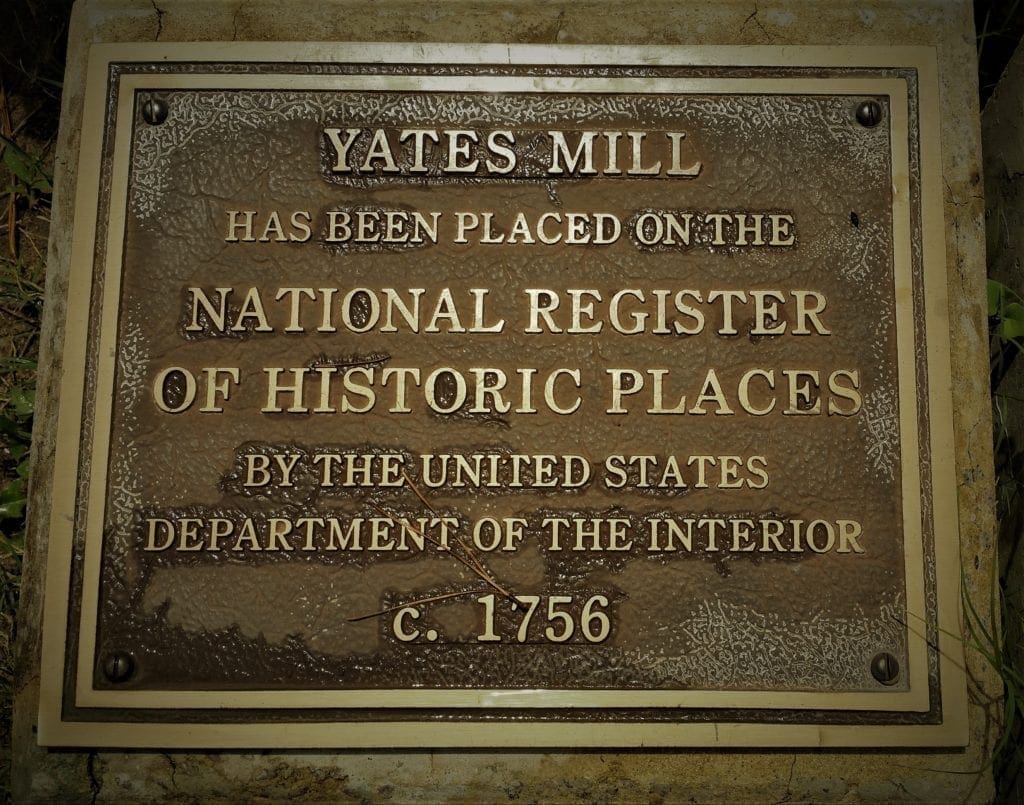
Fran Damage
Shortly after planning began for Yates Mill County Park, Hurricane Fran breached the dam, drained the millpond and caused the shed to collapse in the Fall of 1996.
The mill narrowly escaped destruction when rains unleashed by Hurricane Fran burst its 250-year-old stone dam.
The mill and its pond were badly damaged, but thankfully not beyond repair.

-
-
- The Wake County Board of Commissioners approved the park’s master plan in 1997.
- In 1999, Development of the 174-acre historic and environmental park began
- In 2001 N.C. State leased 157 acres to Wake County. In addition, Wake County bought 16 acres upstream and signed a memorandum of understanding with the N.C. Department of Agriculture for the development of hiking trails on 400 acres of land upstream from the pond.
- Restoration of the mill and its grinding machinery was finally finished in 2005.
- Construction of the visitor center for the park began in summer 2003, and was completed in April 2006.
-
- Historic Yates Mill County Park finally opened to the public May 20, 2006, and welcomes more than 100,000 visitors annually!

You can get involved! For more information on how to become a member of Yates Mill Associates, please visit: www.yatesmill.org.
Looking to volunteer? Learn more about volunteering.
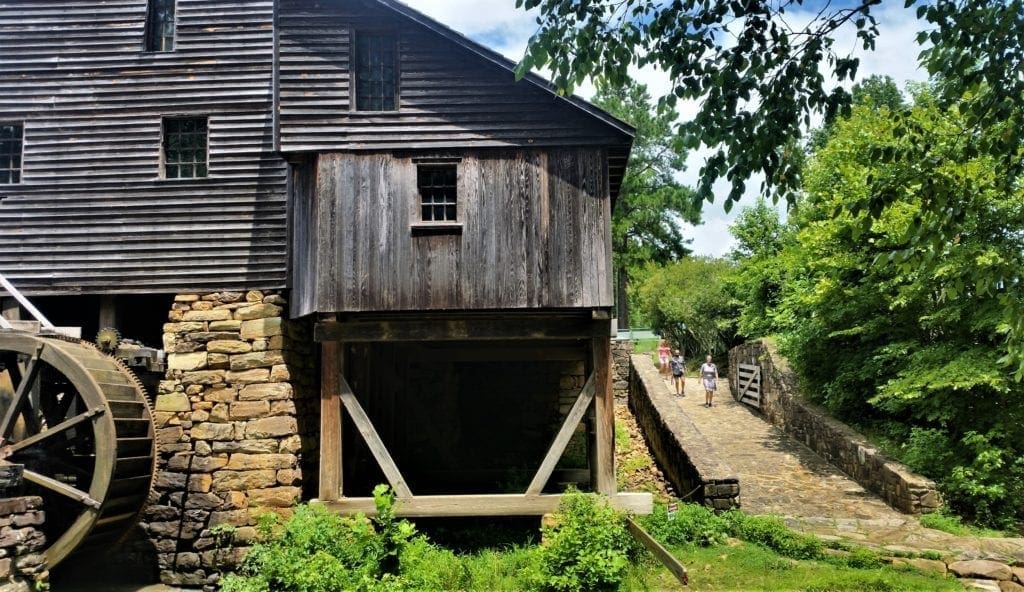
About the Mill
The centerpiece of Yates Mill County Park, Yates Mill (est. 1756), is the last surviving operable water-powered gristmill of the 70 that once existed in the area and is one of the oldest buildings in Wake County.
For nearly 200 years the water-powered mill produced lumber, milled corn and wheat, and carded wool.
The equipment you’ll see in the mill today is original, left after the Lea family ceased milling operations in the mid-1950s.
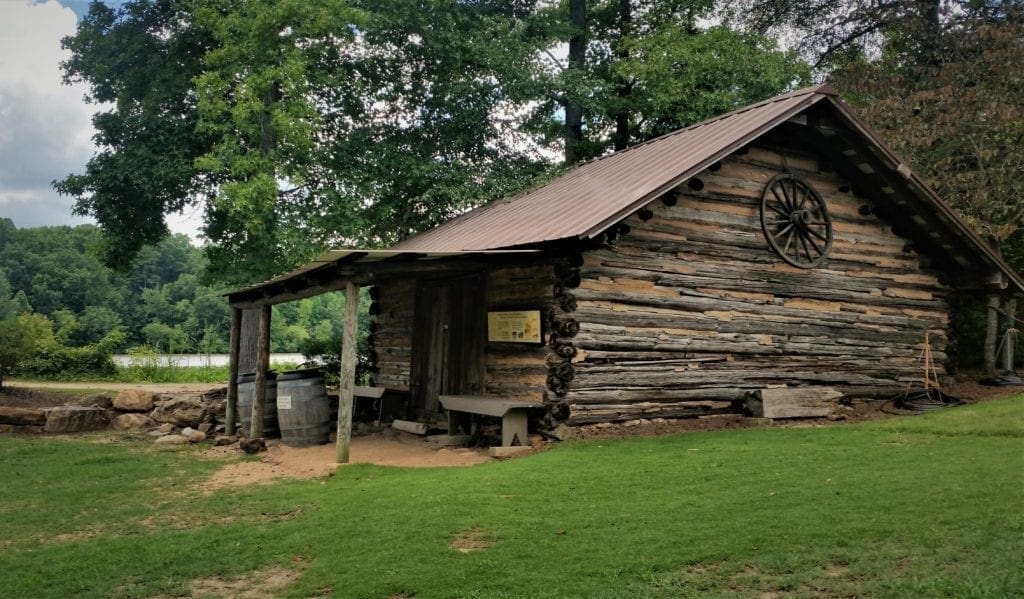
Mill History
The best way to track the history of Yates Mill is by following the initial land grant and transfer of ownership over the years.
WARNING: I go into full History Geek mode for a little bit here. If you don’t wish to read these very interesting historical tidbits, please use the Table of Contents above to skip over this part 😉
1750–1802, Samuel Pearson
Samuel Pearson, the mill’s founder, first acquired property in the Wake County area around 1750, when he purchased land from John Monk.
The earliest known document related to Steep Hill Creek and the land that now surrounds the mill – a request for a land survey – dates from 1756.
This survey appears to also have included the land where Pearson’s home stood.
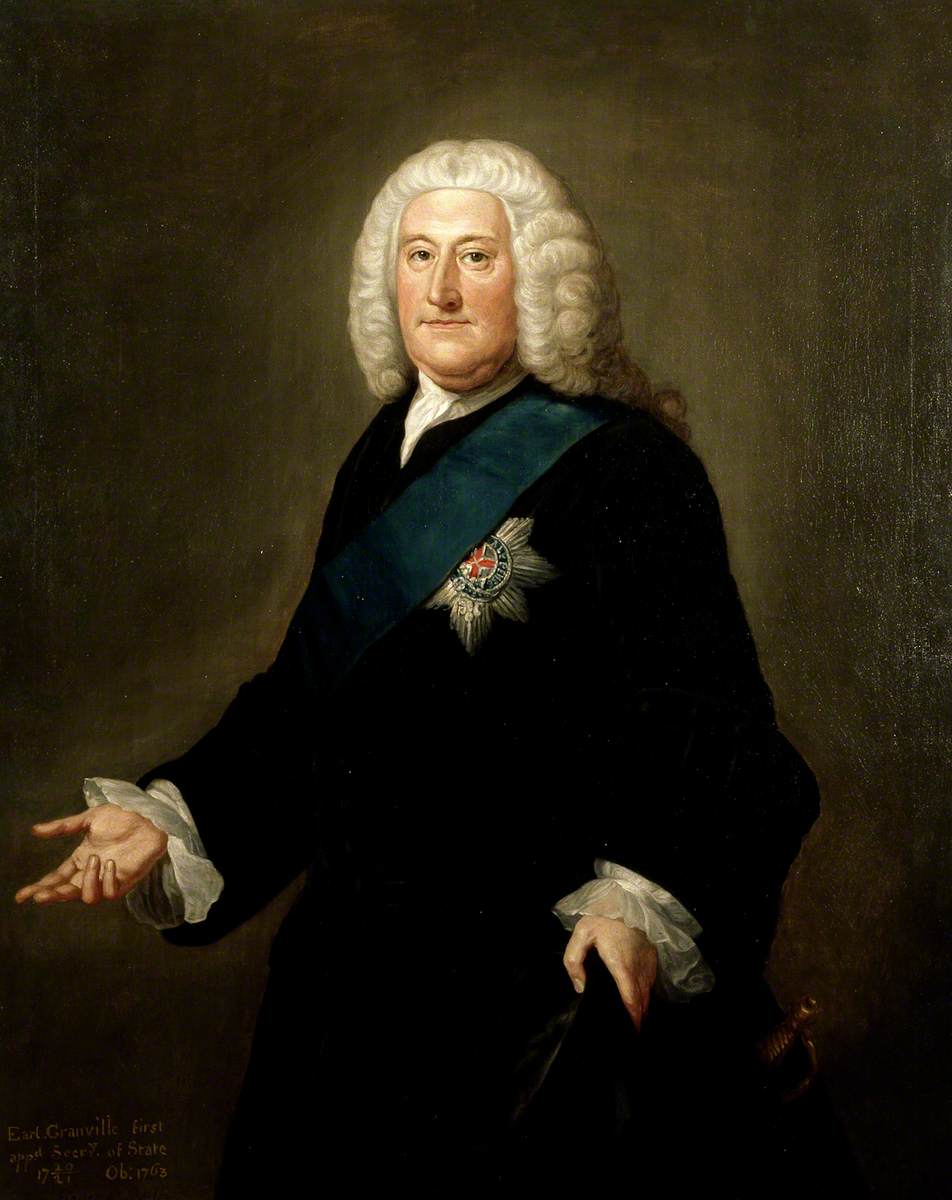
Samuel Pearson officially received the related land grant in 1761 from the Earl of Granville, one of the North Carolina colony’s Lord Proprietors.
In March 1763, Pearson submitted an entry claiming ownership of the land where he built the mill.
The British land office ceased operation after the Earl of Granville’s death later that year, so there were no more documents from that office relating to the land grant.
The start of the American Revolution several years later further delayed the issuance of new grants.
No additional action was taken until 1778, when the new State of North Carolina issued Pearson a survey for the same land that he claimed in 1763.
This 1763 survey is the first known document on file that specifically mentions the mill as already standing.
Pearson steadily increased his land holdings, and owned more than 600 acres – including the mill – until the time of his death in 1802.
1802–1819, Simon Pearson
Because of debts owed to the State Bank of North Carolina, Simon Pearson was forced to sell his land, including the mill, in a sheriff’s sale in 1819.
1819–1853, William Boylan
The sheriff sold the property for $3,031 to William Boylan, a prominent Raleigh businessman and director of the State Bank.
In order for the mill to continue as a successful business, Boylan made constant changes to the mill building and its operation.
Architectural evidence shows that major renovations were made to the structure between 1820 and 1850.
This overhaul was likely due to a flood in the early 1800s, which probably destroyed the original mill. Despite that setback, Boylan had a sawmill operating at the mill site by the 1840s.
Mr. Boylan owned the mill for 37 years. He sold it to John Primrose, Thomas H. Briggs and James Penny on June 30, 1853.
1853–1863, John Primrose, James Dodd, Thomas Briggs, James Penny
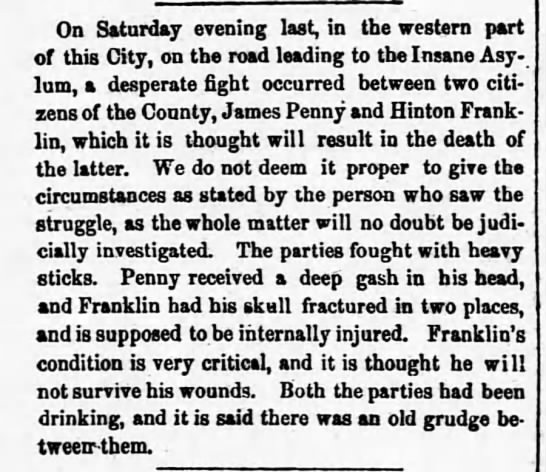
Thomas H. Briggs, a prominent Raleigh businessman, started a building materials business that continues today as Briggs Hardware.
In 1859, James Dodd bought Primrose’s share of the mill – which left Thomas Briggs, James Dodd, and James Penny in partnership.
A decade later, in the midst of the Civil War, the mill was sold again.
James Penny’s involvement in the murder of a Mr. Hinton Franklin may have brought on the sale.
1863–1902, Phares and Roxanna Yates
On March 2, 1863, Penny, Dodd and Briggs sold the mill and 94 surrounding acres to to Phares and Roxanna Yates, James Penny’s son-in-law and daughter.
In 1865, Hinton Franklin’s widow supposedly told Federal troops occupying Raleigh that her husband was murdered due to his political beliefs.
In response to her allegations, the soldiers tried to burn down Yates Mill by setting fire to it’s entrance porch.
Charred wooden beams from the mill’s underside are evidence of the attempted burn.
Court records show that James Penny was tried for the murder of Hinton Franklin in December 1866 but was found Not Guilty.
The Road to the Insane Asylum
The North Carolina General Assembly of 1862–1864 met in Raleigh several times per year to administrate as needed for the city.
The Civil War was ongoing during the entire term of this assembly.
During this time, the Assembly passed public laws and approved appropriations of funds, including resolutions for the funding of the Dix Hill Insane Asylum (later known as Dorothea Dix Hospital).
It was also during this time, in 1863, that the desperate fight with heavy sticks occurred on the road to the Insane Asylum between James Penny and Hinton Franklin, allegedly over a debt owed by Franklin to the Yates Mill.
The combatants may have been drinking.
The altercation resulted in the death of Mr. Franklin, the sale of the Yates Mill and property, and the December 1866 murder trial of Mr. Penny.
He was found Not Guilty.
Upon his death in 1902, Phares Yates left his real estate and the mill on Steep Hill Creek to his son, Robert E. Lee (R.E.L.) Yates.
1902–1937, Robert E. Lee (R.E.L.) Yates

1937–1947, Minnie John Yates
1947-1963, Trojan Sales/A.E. Finley
After the mill shut down for business, it began to fall into disrepair.
Ten years later, North Carolina State University acquired the property, consolidating it into a larger tract to be used as an experimental farm.
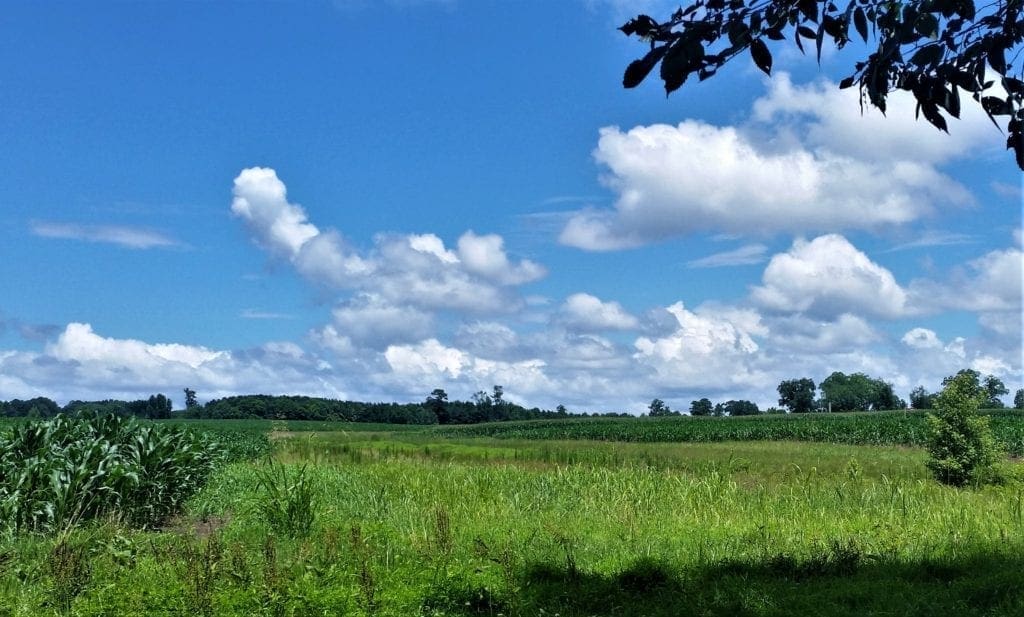
1963–present, North Carolina State University (NCSU)
After the University acquired the property, John Daniel Lea – the miller who had worked at the mill since 1898 – operated the mill for the last time as a demonstration.
1989, Yates Mill Associates Forms
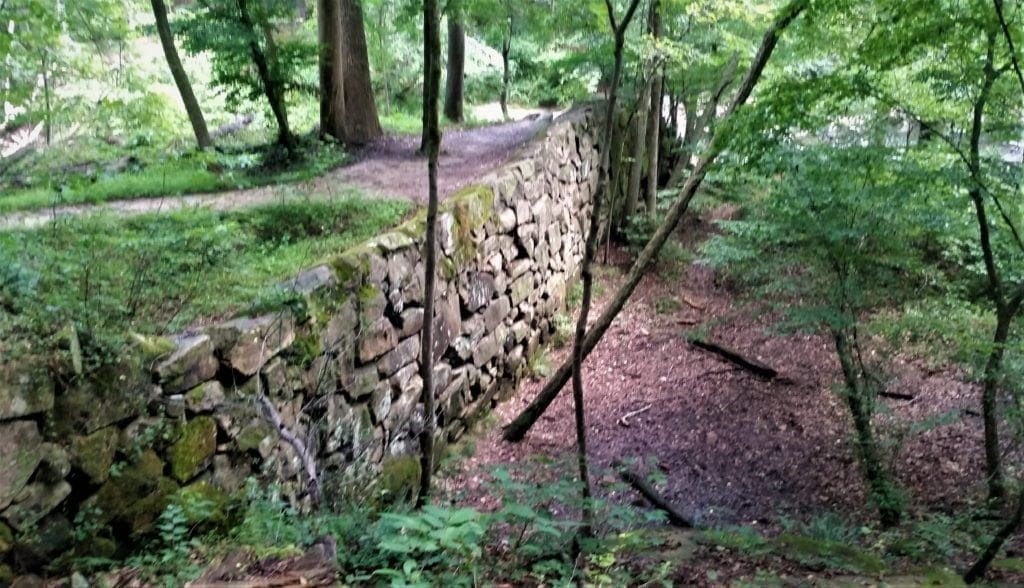
Other Nearby Historic Mills
The area that now includes Umstead State Park was populated as early as 1800, as small farms sprung up in the area around Crabtree Creek in northwestern Wake County.
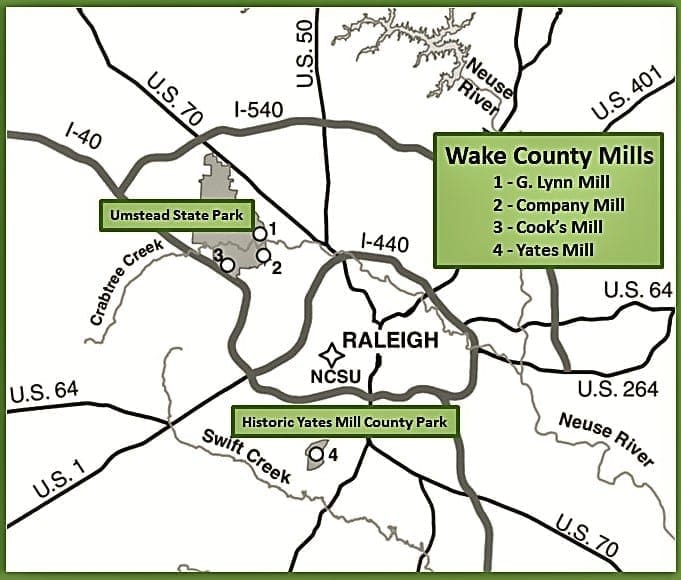
There were at least seven water-powered grist mills in the area of what is now Umstead State Park – and the remains of four of them, including the Yates Mill, are still easily recognizable.
Page Mill, the oldest and the best known mill inside Umstead Park, was built in 1810.
Another mill, located on the very edge of the park on Ebenezer Church Road, was called Blake’s Mill.
Other mills populated the area, including the George Lynn Mill on Sycamore Creek (1871), and a later mill on Reedy Creek. They all ground mostly cornmeal.

Page (Company) Mill and George Lynn Mill
Anderson Page, an early entrepreneur and industrialist, first established Page’s Mill – a water-powered mill on Crabtree Creek.
It later became known as the Company Mill when a group of men formed a company and took ownership of it.
Wake County residents would travel from miles around along Old Middle Hillsboro Road (now Reedy Creek Multi-Use Trail inside Umstead State Park), then south along Mill Road to Crabtree Creek to grind corn and catch up on local gossip.
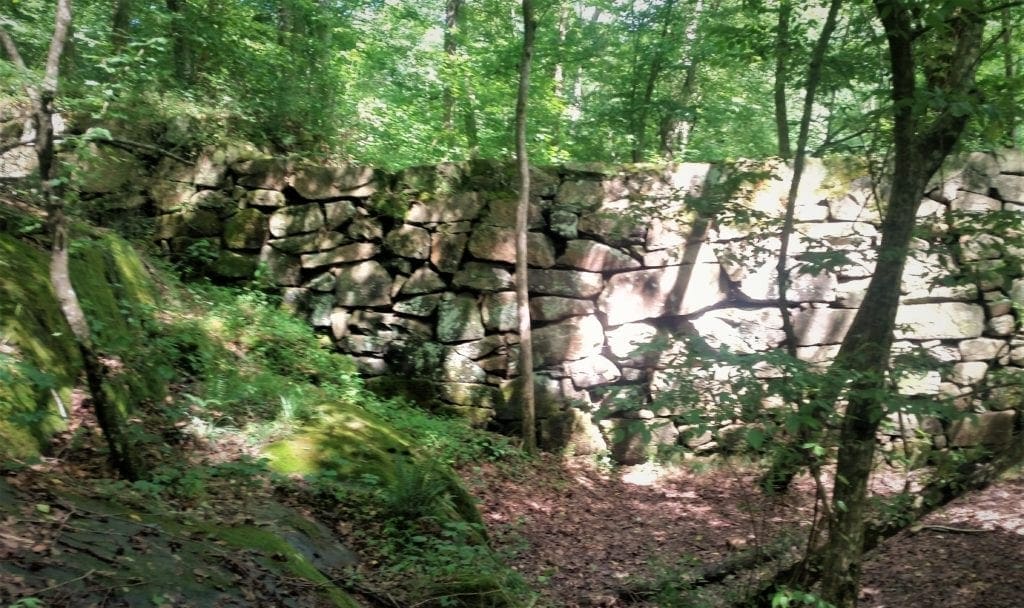
Portions of a dam wall built at the mill site are still visible along the southern banks of Crabtree Creek within the park.
Hikers may recognize the name from the Company Mill Trail, a 6 mile trail inside Umstead State Park that passes by the mill ruins.
The Old Company Mill operated until it washed away in a flood in the Spring of 1939.
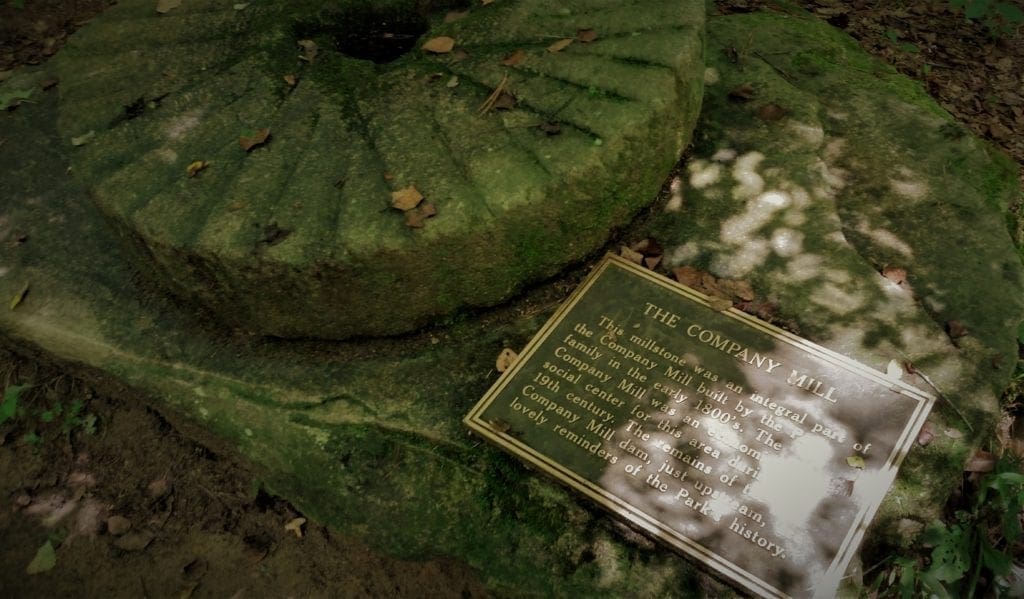
The Company Mill’s millstone was preserved and decorated with a bronze plaque explaining the history of the site — an honor many of the abandoned structures, overgrown and crumbling in the woods, didn’t receive.
The remains of the George Lynn Mill on Sycamore Creek are less substantial but are still enjoyed by park visitors.

The dam forms a large and visible landmark, where families and children can be found climbing, fishing and playing on nice days.
What is a Grist Mill?
By 1840 the United States had over 23,000 grain mills.
While some were commercial flour mills milling and sifting flour for distant markets, most were neighborhood grist mills, selling the service of grinding to nearby farmers.
“Grist” is grain, and grist mills of this same design have used water power to grind grains into meal for baking since at least the first century B.C.
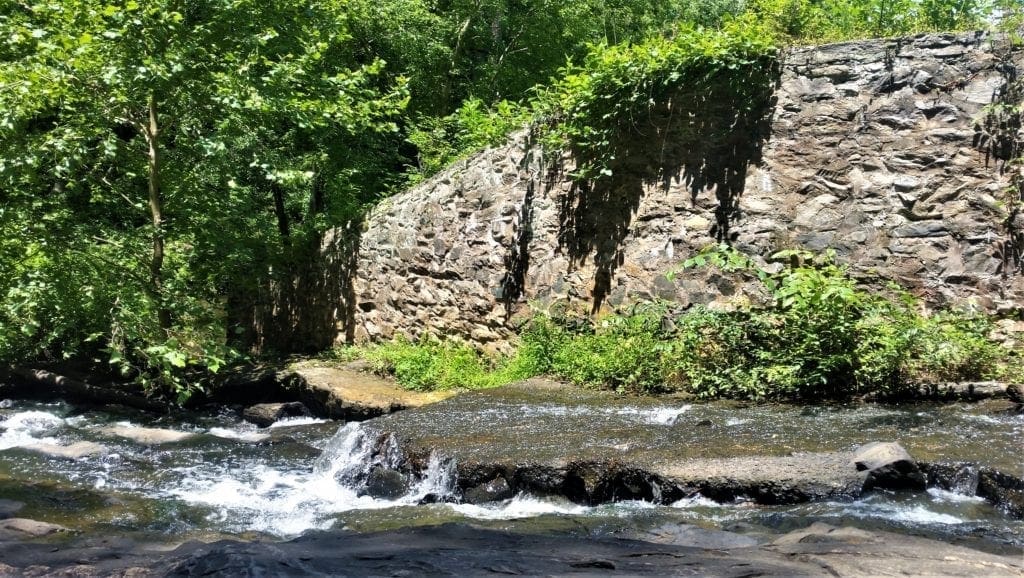
The customer paid a toll – a small fraction of the grain he brought to the mill – in exchange for having his corn, rye, or wheat ground into meal.
How Does it Work?
To operate the mill, the miller places the grain to be ground in the funnel-like hopper above his pair of millstones, after first taking out his toll.
Then he opens the sluice gate that lets water into his water wheel.
THE POWER OF WATER
There are three main principles of water power:
-
-
-
- Flow – The volume (amount) of water. The greater flow, the more power obtained.
- Head – The height of the fall of the water. The greater the height, the more power obtained.
- Efficiency – The measure of how well a waterwheel captures the weight (from the flow) and force (from the head) of the water. Greater efficiency generates more power.
-
-
Water can only do its work when there is both head and flow. The earliest mill sites were those where there was a natural fall of water (a waterfall) which created head and flow.
If there was no natural fall, head was created by building a dam like they did for the mills in Wake County.
Dams often created ponds behind them, which stored water and effectively increased flow as well.
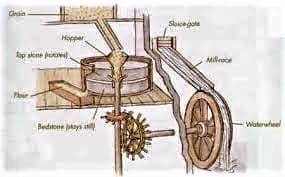
As the weight of falling water turns the water wheel, large gears turning smaller gears make the shaft turn faster, like the pedals of a bicycle turn the smaller gears on the wheel.
This power is transmitted to a vertical spindle, upon which rests a large, flat disc of stone, often weighing a ton or more.
This stone spins just above, but not quite touching, an identical stone set stationary in the floor of the mill.
Both stones have a pattern of grooves cut into their faces.
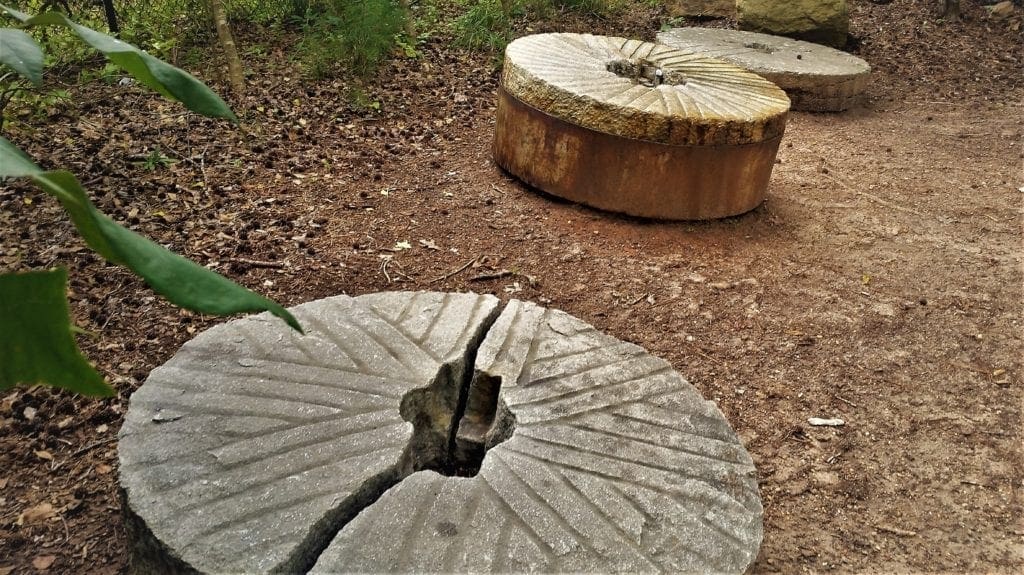
As one stone turns above the other, their grooves cross much like scissor blades. Grain falling through the hole, or “eye”, in the runner stone is cut apart as it passes between the two stones.
The miller can adjust the distance between the stones to regulate how finely the grain is ground.
The milled grains move around the cover over the stones, until it falls through a hole into the meal chest.
From there it can be scooped up into a sack to be taken home for baking.

Park Trails
The historic Yates Mill building sits on the east bank of a twenty-acre pond surrounded by a forested nature preserve to its north and west.
A boardwalk that crosses the northern end of the pond provides visitors with a great view of the pond and gives direct pedestrian access to the park’s hiking trails.
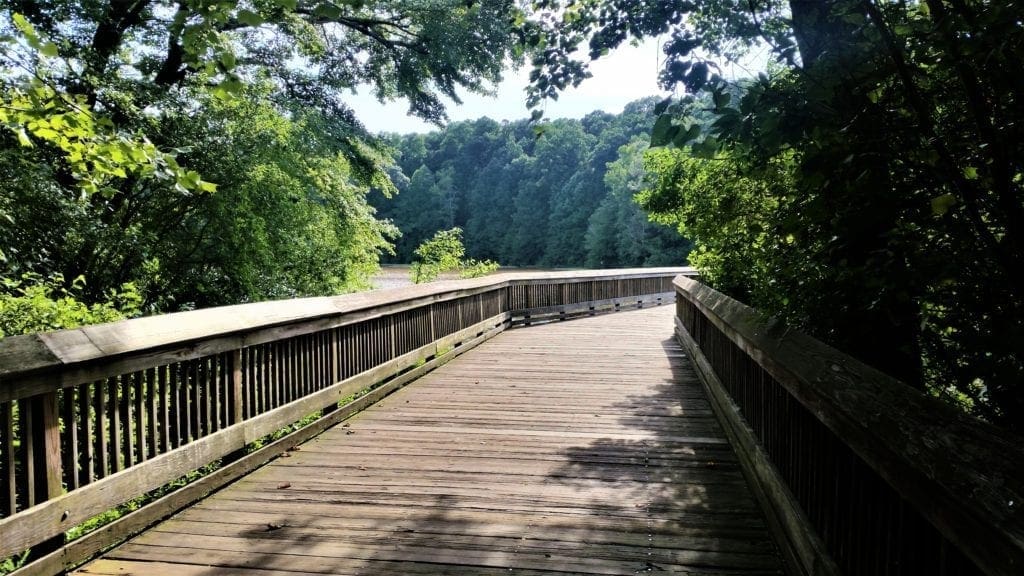
Hiking Trails
The trails at Yates Mill County Park are all fairly short (1 mile or less one way), pretty shady, and relatively flat. So, not great fitness trails for regular hikers or runners.
That said, this is a wonderful place for a casual outing with the kids or to take a break from work or just get out of the house for a while!
The trails are great walks for kids, or a good break at lunchtime – especially since you can stop and have a picnic at one of the benches along the way.
The view is the best from the Pond Boardwalk, and the covered benches on the Wetland Boardwalk are a great place for a snack.
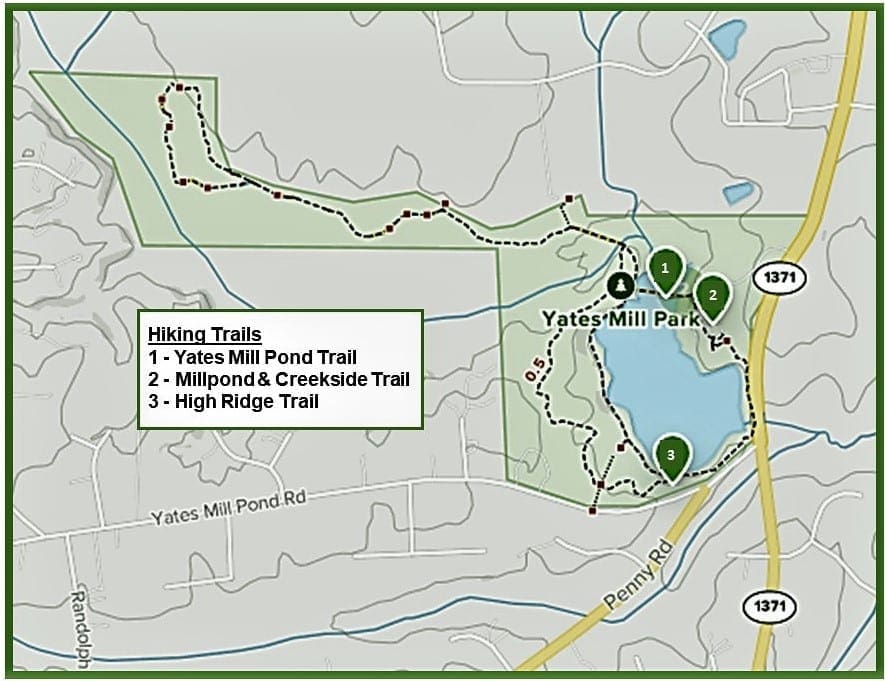
All of the Park’s hiking trails close a half-hour before sunset.
You can pick up a copy of the Tree Identification Trail brochure at the Finley
Visitor’s Center, or if the office is closed, you can access the brochure here and print the tree list from your own printer.
Be sure to check out the park’s wildlife interpretation stations and wayside exhibits along the different trails.
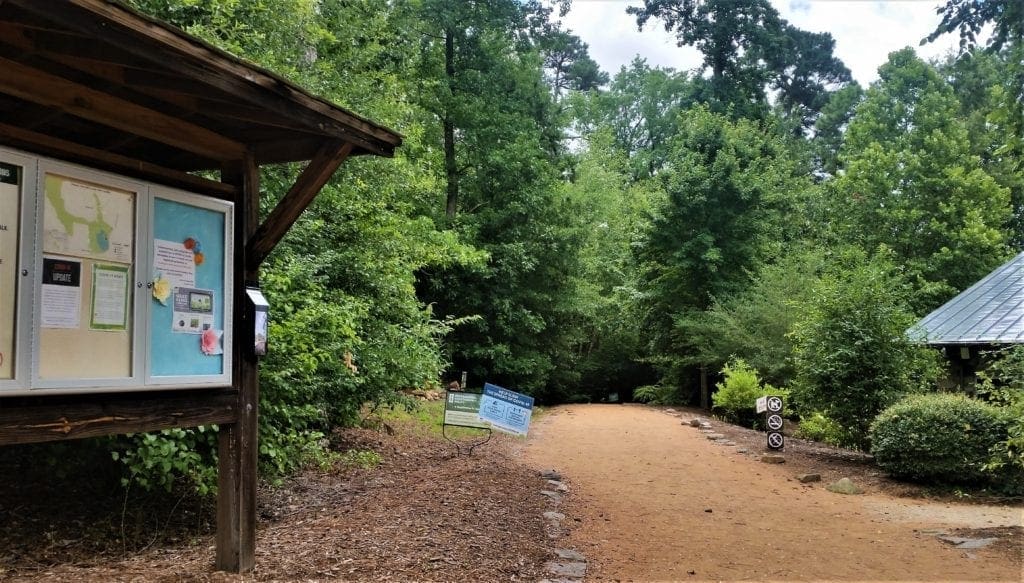
Mill Pond Trail
(1 mile—easy to moderate. Blue blazes.) The Millpond Trail is an easy 1.0 mile loop that goes clockwise past the AE Finley Center to the Historic Mill along a crushed gravel path, then continues past the mill across the creek and up around the lake.
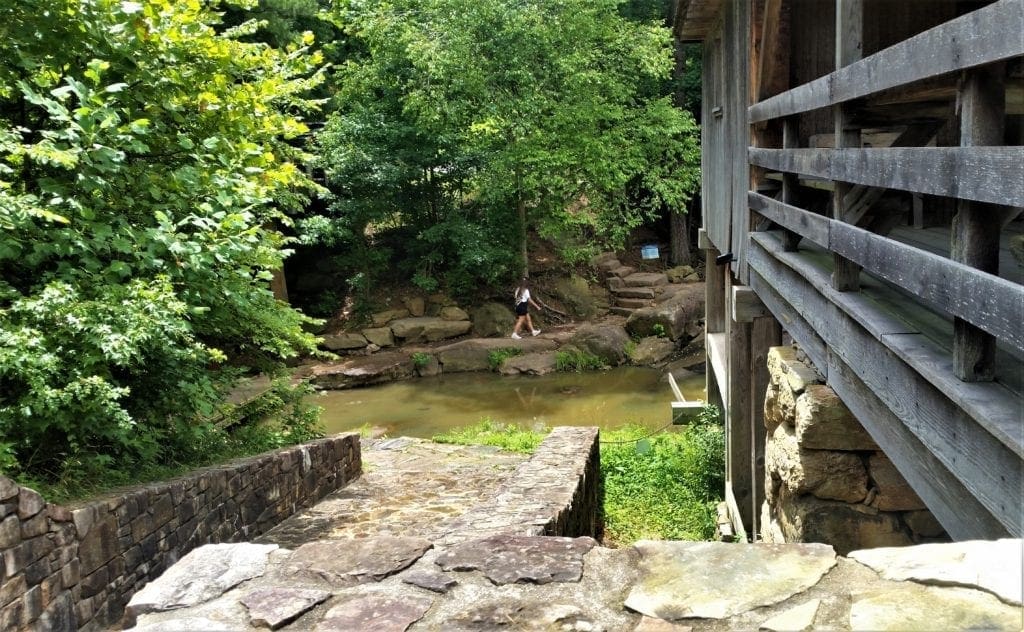
This trail includes an accessible gravel pathway to the mill, a stone ramp to a low bridge over the creek (may be closed during flooding), stone steps through the old miller’s residence area, and the pond boardwalk.
Lined with benches, the trail passes the field classroom half way around and then returns to the parking area across the Pond Boardwalk (fishing allowed with a permit).
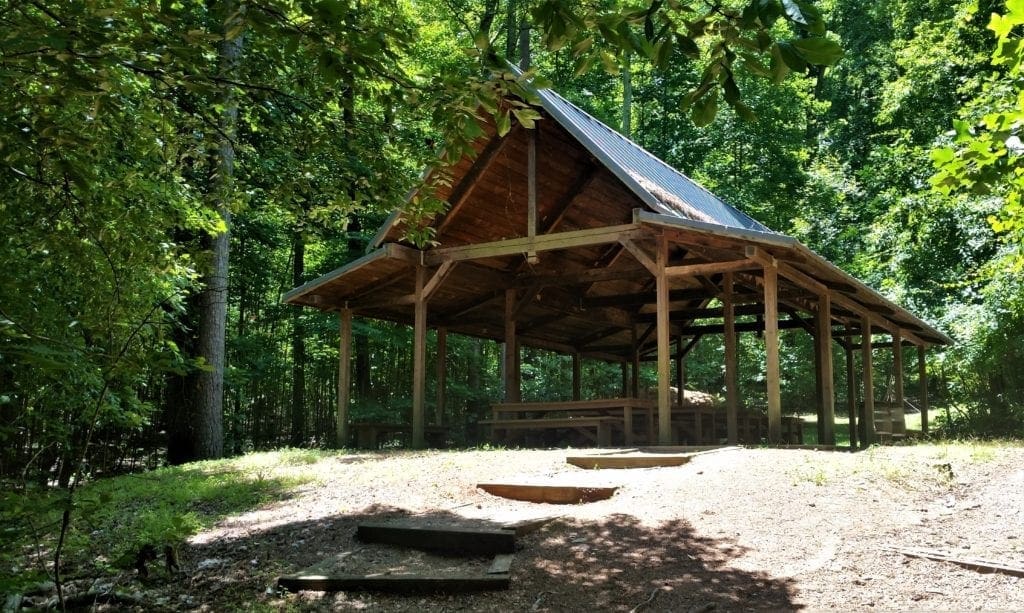
High Ridge Trail
(0.8 mile—Strenuous. Green blazes.) High Ridge Trail winds up along a ridge from the Yates Mill County Park Millpond Trail and reconnects further around the lake.
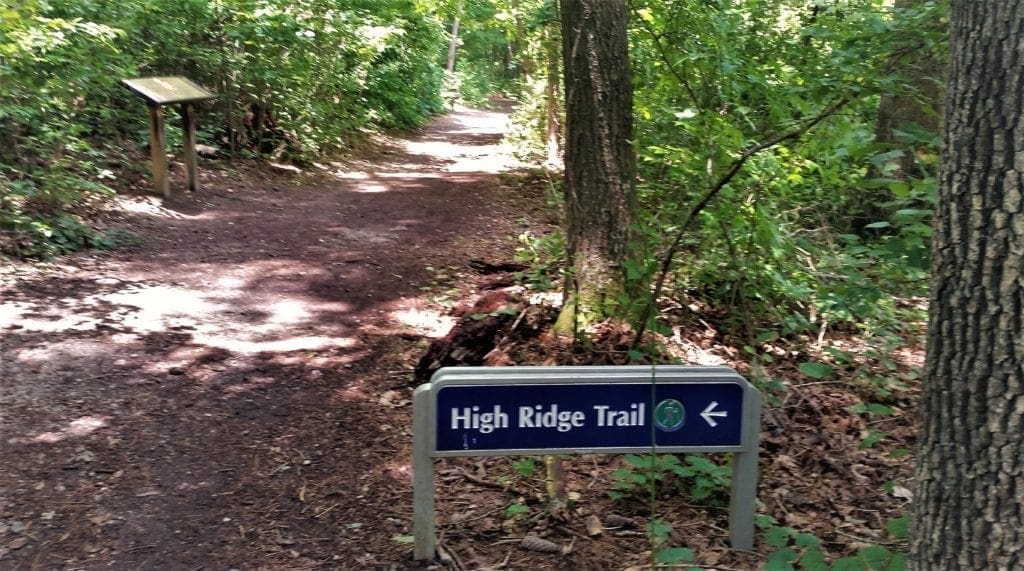
This naturally surfaced trail travels along the ridges above the pond through mixed old field pine, hardwood forests and north-facing bluffs. (When combined with the Millpond Trail, it makes a 1.25 mile loop.)
Despite it’s “strenuous” rating, this lightly trafficked loop trail is good for all skill levels, and is accessible year-round.
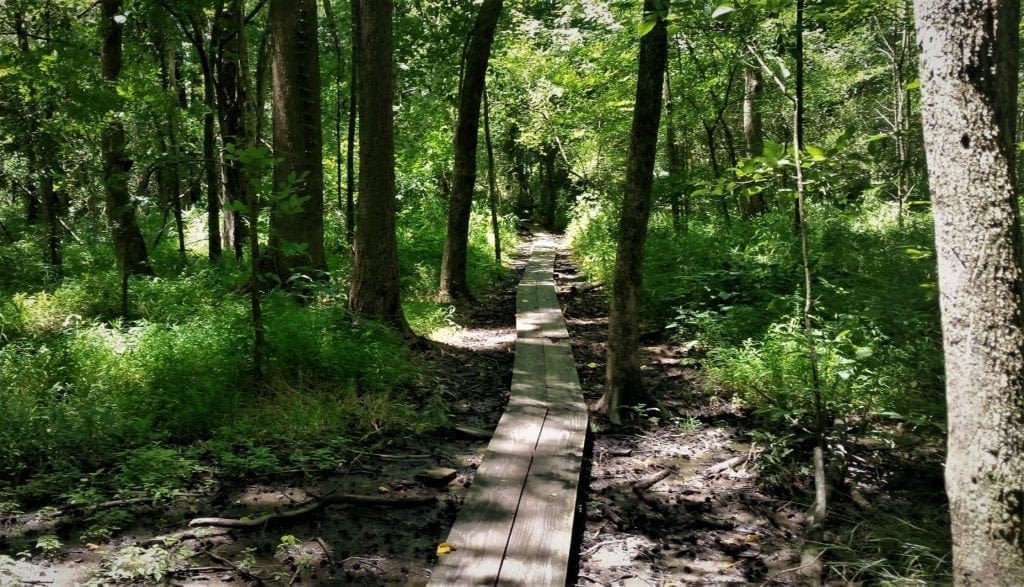
Creekside Trail
(1 mile one way—moderate. Red blazes.) This linear trail crosses over several wetland areas by way of footbridges and wooden walk-boards.
Mostly flat, it’s accessed from the north end of the Wetlands Boardwalk.
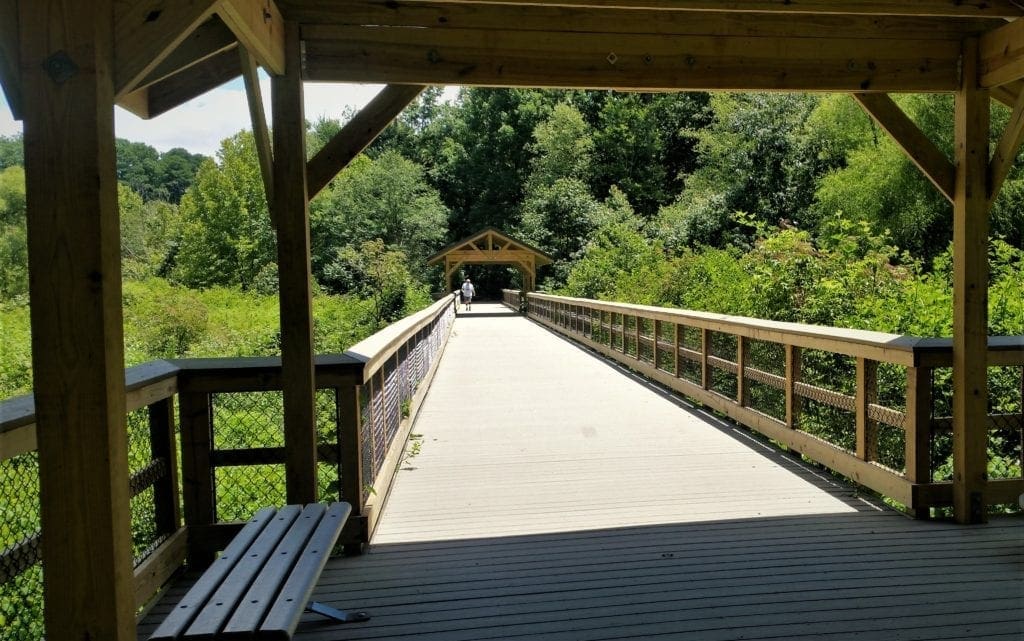
Once you cross the long bridge leading away from Yates Mill Pond, a sign will guide you to the left for the Creekside Trail.
This trail starts out along a very flat stretch through a low creek bed.
This trail could also be called the “Fieldside” trail as it travels for a ways beside NC State’s fields in the Agroecology Farm.
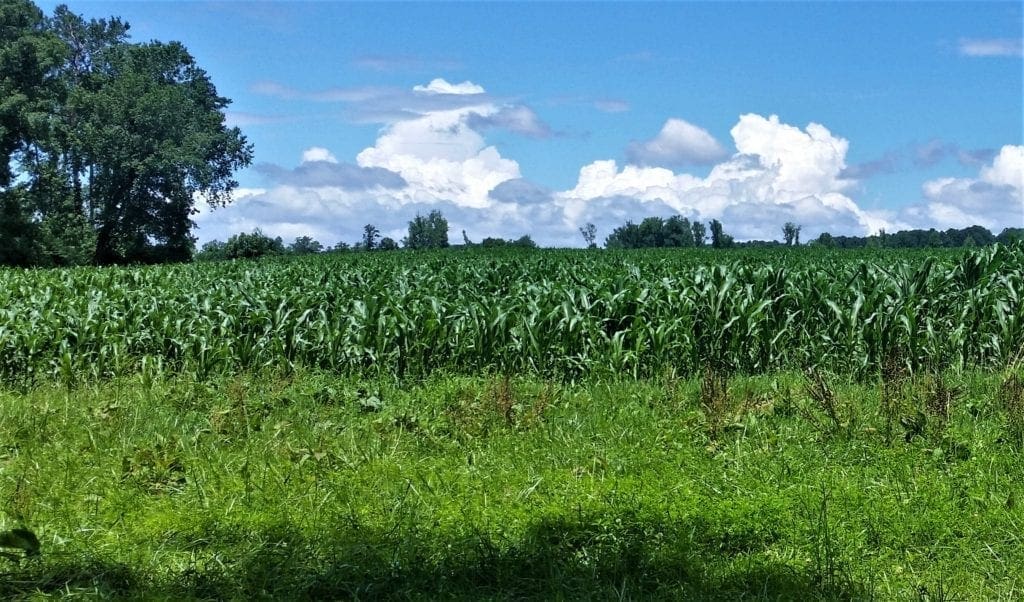

The Agro-ecology Education Farm
You can see it’s corn fields from parts of the Creekside Trail, and there is a side- trail leading from the park to the farm.

(Currently closed to park visitors due to COVID-19 concerns.)
The Agro-ecology Education Farm, adjacent to the park, is run by NCSU.
In 2005, the Agroecology Education Farm was started to create a space for students and community to learn about sustainable agriculture.
The Historic Yates Mill Park was a big supporter for the farm from the very beginning, and developing it near the Park was important to demonstrate sustainable agriculture near a natural area.
In 2013, the farm began producing for NC State University Dining, helping to bring agroecology education – and good food! – to campus dining halls.
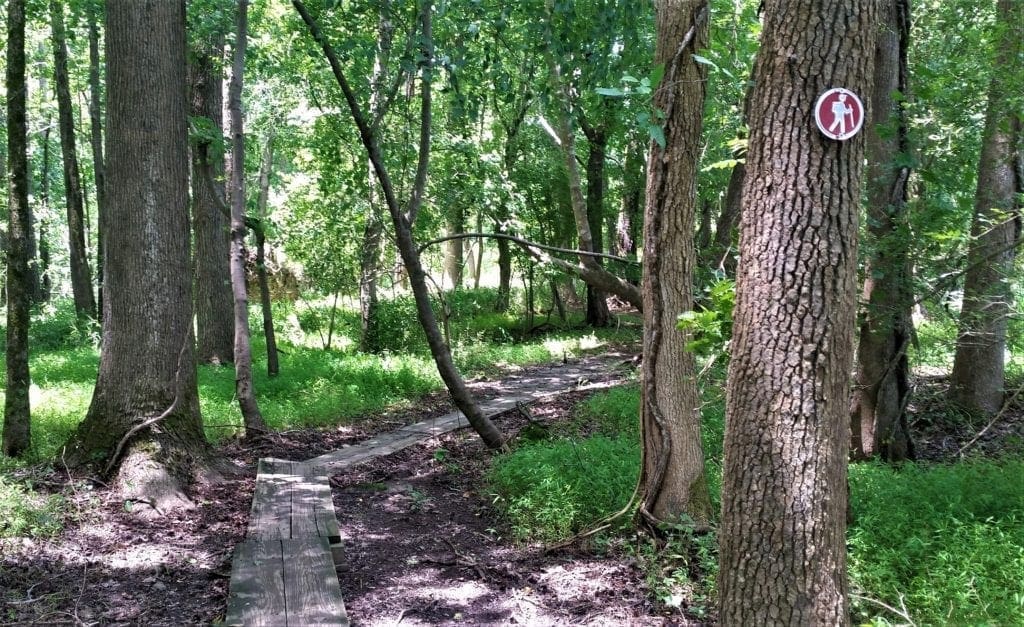
The Creekside trail travels along the Steep Hill Creek floodplain and uses several footbridges and boardwalks to cross the swampy, muddy areas.
After a short loop at the end of the trail, hikers will retrace their steps back to the boardwalk for a total of 2 miles.
The Tree Trail
(0.44-mile moderately easy) This one-way self guided trail will introduce the hiker to twenty of the numerous tree species found at Historic Yates Mill County Park.
As you walk the Tree Trail, you’ll notice numbered posts.
These posts correspond to numbered tree pictures found inside the trail brochure, along with numbers shown on the trail map.
The brochure includes brief description of each tree, a drawing of the leaves for identification, and an interesting fact for each tree.
Once you’ve completed the tree trail, you may return by using the same trail. You could also take the 0.78-mile High Ridge Trail, or finish the 1-mile Mill Pond Trail.

Visit the Howling Cow Dairy
If you’re in the mood for a cool sweet treat, and more adventure after your visit to Yates Mill, take a quick side-trip to nearby Howling Cow Dairy Education Center and Creamery!
It’s only natural for a university with a 329-acre dairy farm and a nationally recognized food science program to make ridiculously delicious ice cream – and the milk and cream come directly from over 300 NC State cows on their farm in Raleigh.
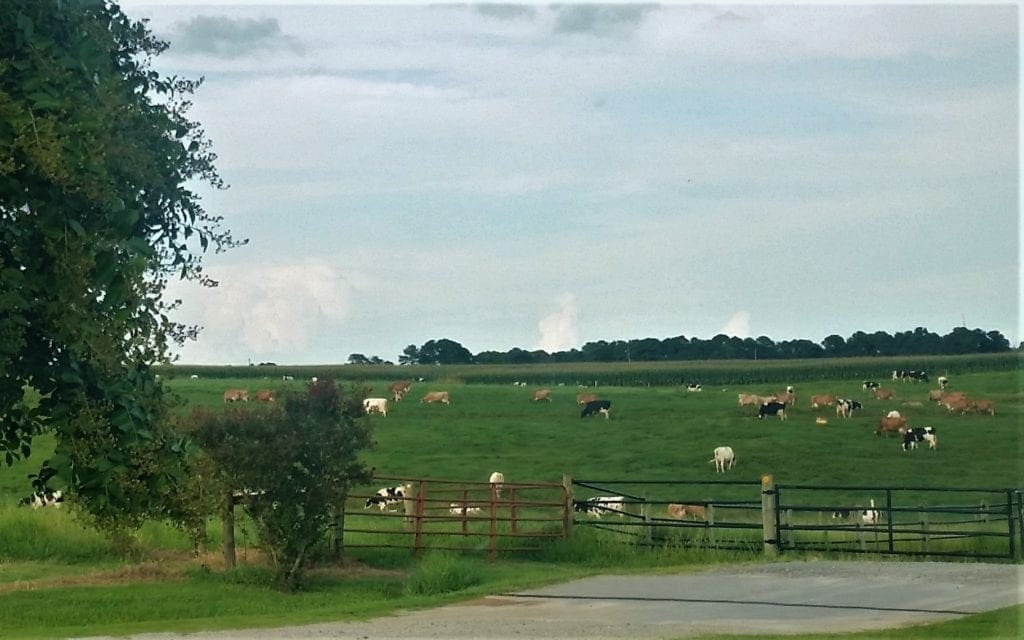
The education center is part of NC State University’s Lake Wheeler Road Field Lab in Raleigh.
While it does provide a place to enjoy NC State’s Howling Cow ice cream, it’s also a destination learning center equipped with interactive video exhibits, too.
Visitors can enjoy an ice cream sundae while learning about the plant’s operations and discovering the many facets of North Carolina’s dairy industry.
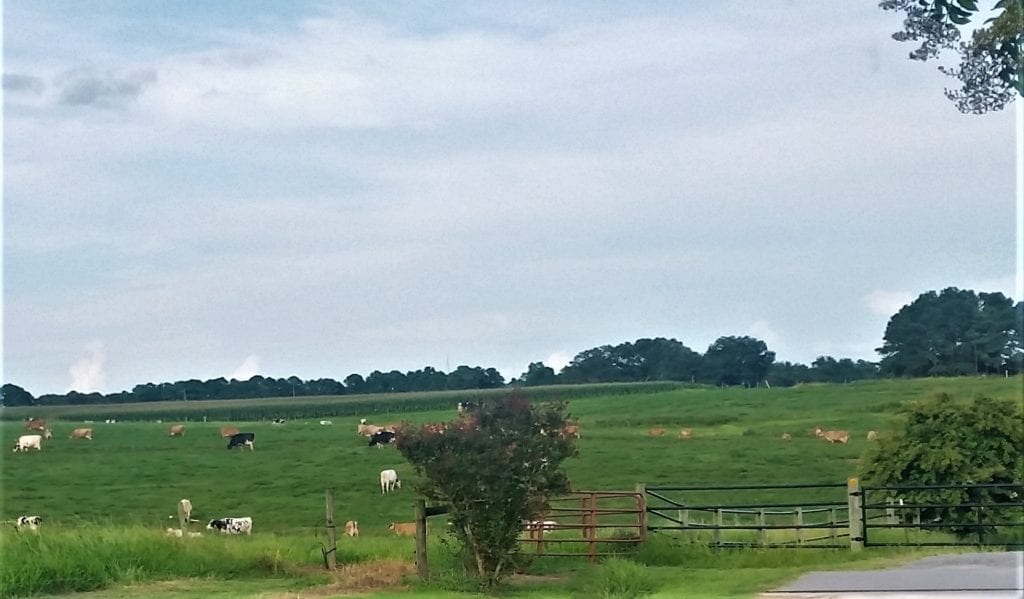
“When people visit we hope they walk away with a new appreciation for what it’s like to get ice cream to the table,” said Carl Hollifield, associate director of NC State’s Dairy Enterprise System.
Visitors can also take a tram ride to see the cows, animal husbandry and see how a farm works.
NOTE: Currently the dairy farm is closed to visitors due to COVID-19 restrictions, but you can still pick up ice cream orders to go in a special drive-thru.

You’re asked to stay in your car to order, but (according to Howling Cow’s Facebook page) you can park, get out and enjoy your scoops on the porch or lawn as long as you keep your distance from other customers.
You’re also welcome to bring lawn chairs or blankets. (NOTE: The bathrooms are not available for customers.)
*Howling Cow Re-opened for Carry-out*
Hours: 3-8pm Wednesday-Sunday
https://go.ncsu.edu/howlingcoworders
Pick up a pint, case of cups, or a 3 gallon tub of your favorite Howling Cow flavor.
Call 919-513-4695 to place your order or just stop on by. Credit Cards Only !!
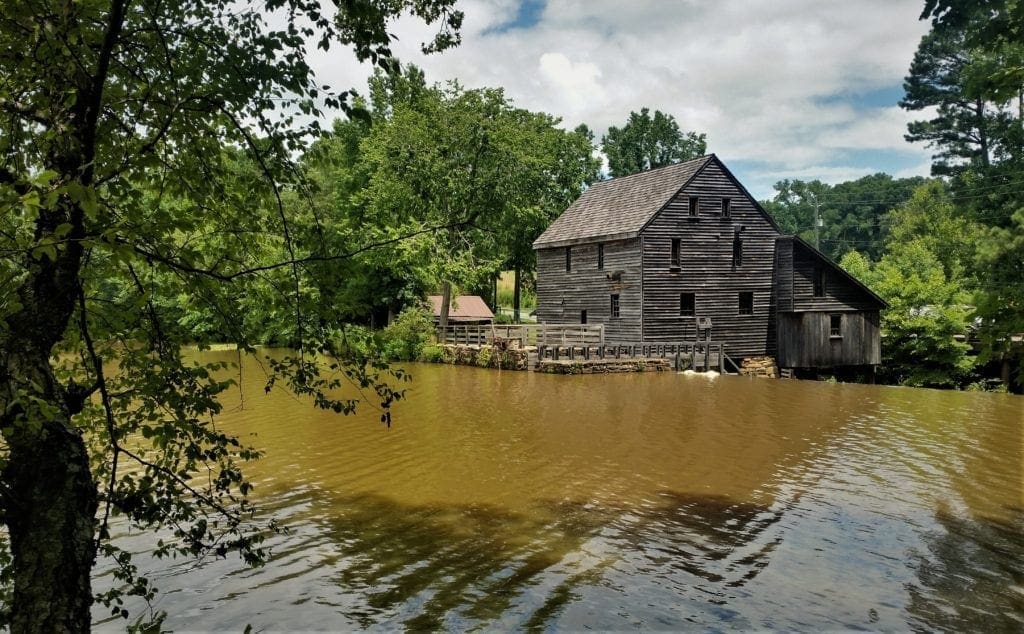
Events at the Park
In addition to hosting it’s own events Yates Mill County Park is home to local school events and other special community events.
Events include children’s programs, adult classes, and even volunteer opportunities in all seasons.
Be sure to look at the park’s Event Calendar, to see what’s coming up.
NOTE: Some events require pre-registration. You can do that on the park website, from the Calendar.
Mill Tours
During your tour, you can learn about how the mill works and why it was an integral aspect of rural life in the early days of settlement in Wake County.
Tour fees directly support the nonprofit Yates Mill Associates for maintenance and operations of Historic Yates Mill.
Looking for other park programs? View the park’s Public Programs page or the park’s Organized Group Programs page.
Visit Info
NOTE: Though the Visitor’s Center is currently closed and tours and events are suspended due to COVID-19 restrictions, the Restrooms in the AE Finley Center are still open. Bring your own water, though.
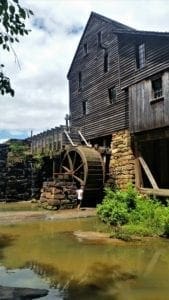 Location:
Location:
Historic Yates Mill County Park
4620 Lake Wheeler Road
Raleigh, NC 27603
Park Hours and Fees:
Open 7 days per week, 8am to sunset.
Free admittance!
A.E. Finley Visitor Center Hours:
Historic Yates Mill Building:
The Park, Center and Mill are closed:
-
-
- Thanksgiving Day
- Christmas Eve
- Christmas Day
- New Year’s Day
-
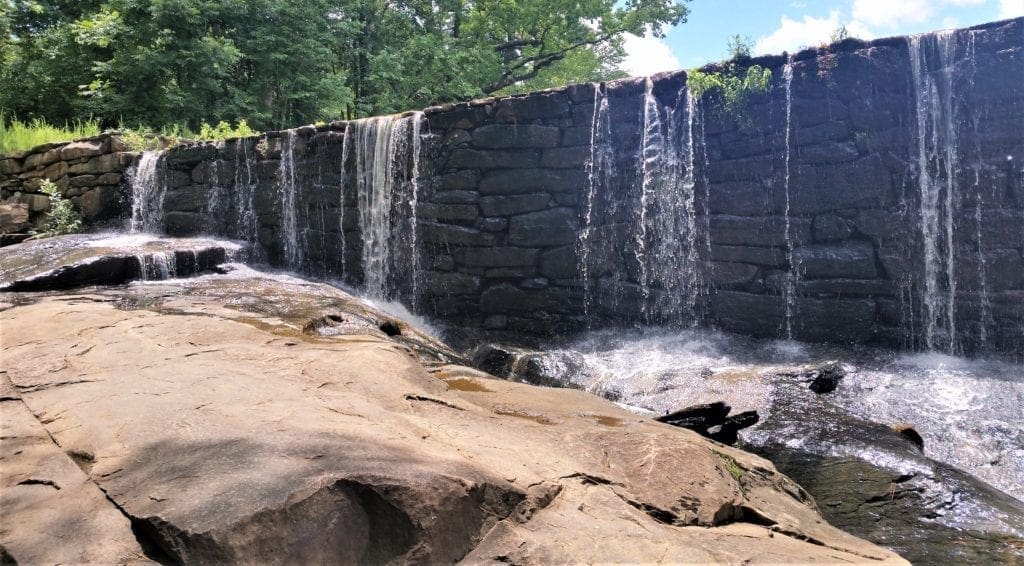
I hope you have a great visit and find your own favorite things to do at Yates Mill County Park!
If you have a question or comment, drop me a note at idratherwalkblog@gmail.com and I’ll reply as soon as I can.
To read about more local and national hikes, and ideas about things to do outdoors with the family, check out my Get Outdoors with Kids and Hiking Destinations pages.
If you’re looking for some travel pointers or ideas for your next out of town adventure, check out my Travel Resources page.
Thanks for stopping by – see you next time! LJ
To Get New Idratherwalk Posts
sent directly to your inbox (how convenient!) Click this Button
If you like this post, please share it!
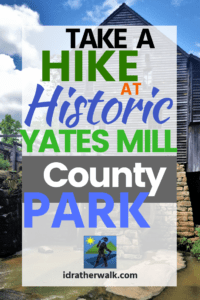

LJ has spent much of her free time as a single Mom – and now as an empty-nester – hiking in the US and around the world. She shares lessons learned from adventures both local and in exotic locations, and tips on how to be active with asthma, plus travel, gear, and hike planning advice for parents hiking with kids and beginners of all ages. Read more on the About page.

